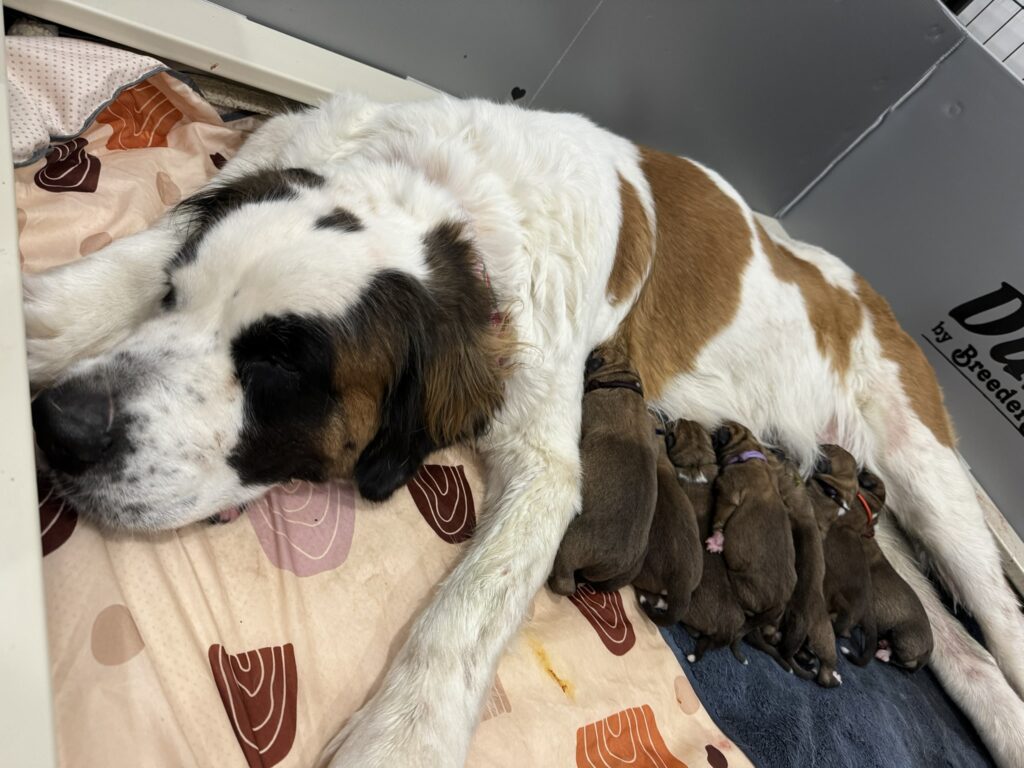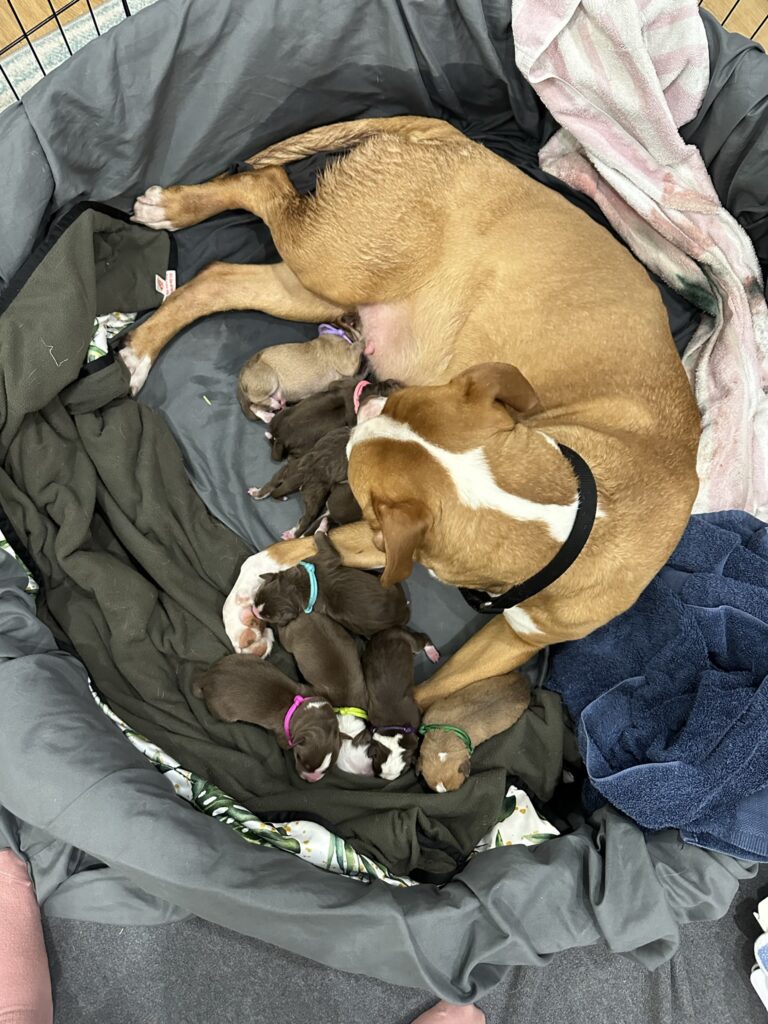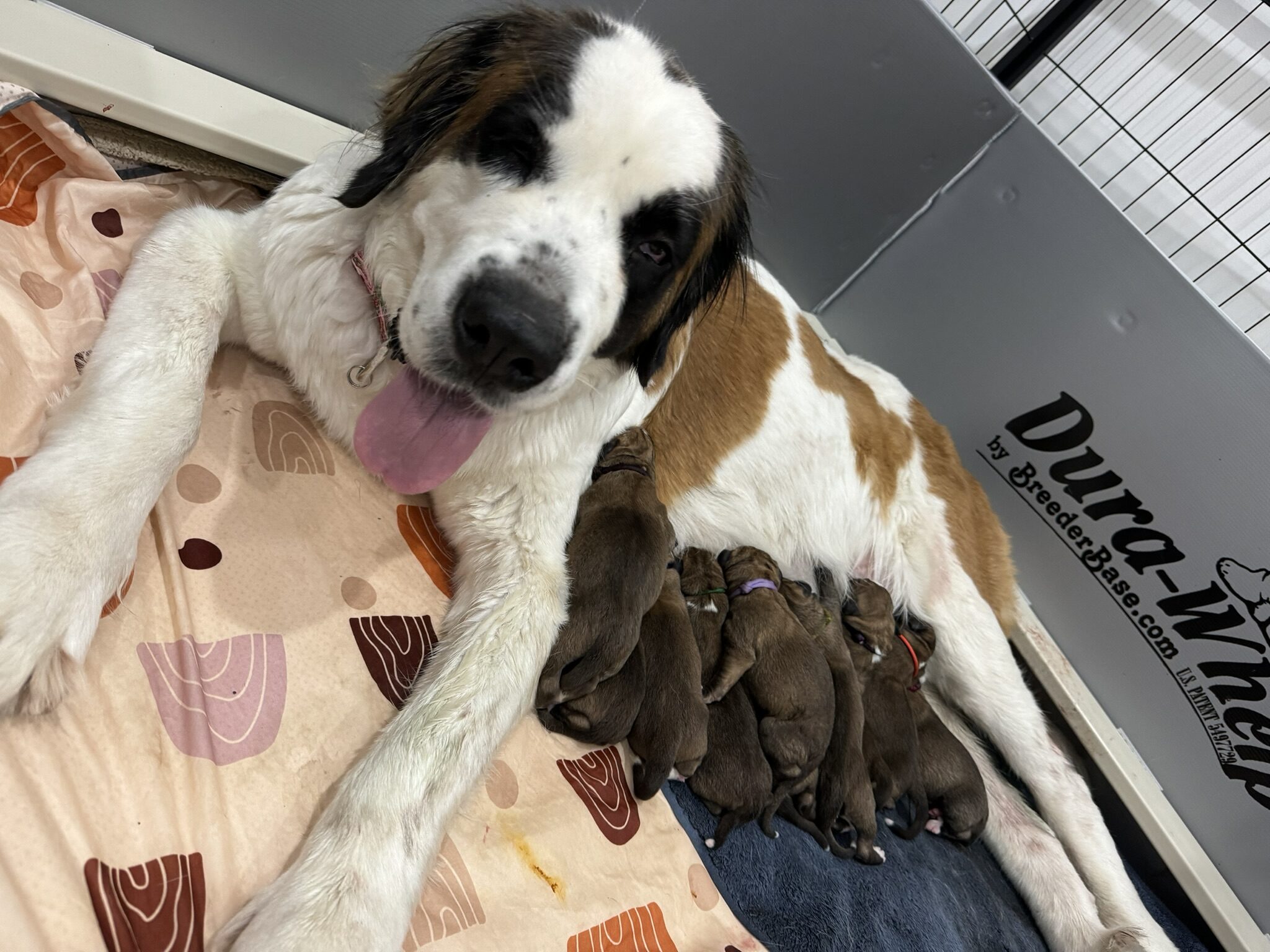While many pregnant dogs have smooth deliveries that require minimal human intervention and are done in the comfort of their home, there can be complications that necessitate greater human intervention or that require emergency services rendered by your local veterinarian. I highly recommend learning about potential complications before your pregnant dog goes into labor so that you can watch for them and take action swiftly!
Possible Complications During Dog Labor
When a dog’s labor is not going smoothly, it is referred to as dystocia, defined as “difficult birth.” This typically means that the dog is having difficulty delivering puppies, whether that is because puppies are too large to deliver, anatomical irregularities in the mama dog or weak contractions. Here are signs that your dog is having a difficult birth and may need to go to the emergency room:
- Puppy stuck in the birth canal
- Weak contractions or four hours of rest but no puppy
- Active contractions but no puppy within 30 minutes
- Stillborn puppy (or puppies) delivered
- Dog in extreme pain
In an emergency hospital, they will likely take vitals of mom and her pups to measure maternal and fetal distress. They will also be better equipped to assess the issue as well as necessitation of surgery or whether medical treatment may be appropriate to try first (which typically strengthens the dog’s contractions and thus make her better able to deliver naturally).
What to do if there is a puppy stuck in the birth canal?
More experienced folks may feel comfortable trying to gently adjust or pull a puppy that is visible from the vulva but is not being pushed out naturally by mom, but anyone who is new or uncomfortable should consider emergency services to prevent accidental puppy death or damage. A puppy may be stuck because it is overly large, in a difficult position or have a birth defect. If there is only one puppy in the litter, it is more common for it to be too large to be naturally delivered.1
You can try to reposition mom or get her to stand up, which may allow gravity to assist in pushing out the puppy; this is often helpful if you think your mama dog is tired or the contractions are not strong enough to push the puppy out and less so that it is physically stuck.
What to do if dog is having weak contractions?
A dog who is having weak contractions may not have the strength or ability to push the puppy out and needs to go to the emergency room, which likely will give her calcium gluconate and oxytocin to help increase the strength of her contractions.2 If medical treatment does not help, a c-section can be performed.3
Weaker contractions may be the result of your mama dog being tired and exhausted from a difficult or longer delivery, which can occur with a larger litter. It is good to have vanilla ice cream on hand, which is very appetizing to dogs (who often do not want to eat in the moment) and provides a burst of energy to help them finish the labor.
It is not uncommon for your dog to rest for two hours between delivering puppies, but if there are more puppies to be delivered, they should be delivered within four hours of the previous puppy. If she has been actively trying to push a puppy out for more than an hour, there may be a complication that will require medical intervention.
What to do if dog is having contractions but there is no puppy delivered?
For the first puppy delivered, if there is green discharge (which occurs when the amniotic sac and placenta separate, and this results in a “timer” for when puppies need to be delivered) and no puppy within 30 minutes, it becomes an emergency.4
Generally, a puppy should be delivered within 30 minutes of strong contractions. If your dog has been actively straining/contracting for longer than this without delivering a puppy, you will want to consult your veterinarian or bring her to an emergency hospital.5

What to do if there are stillborn puppies?
6Unfortunately, stillborn puppies can be possible during the whelping process, even when the labor is going smoothly and all other puppies are delivered easily. In the case of a smooth delivery, stillbirth is more likely to occur with the last puppy delivered and with larger litter sizes.7 Stillborn puppies are more likely to have very low or high birth weights.
Generally, if the first puppy is stillborn, it may be a sign that your dog is having or will have a difficult delivery (dystocia), especially if it seemed to take awhile to deliver that first puppy (over 30 minutes of strong contractions).8 If there are multiple stillbirths in a litter, you will definitely want to proceed to an emergency hospital.
Some stillbirths may be preventable, like preventing the puppy from being stuck in the birth canal for a prolonged period of time, but it may have occurred prior to the delivery process and the cause cannot be identified without an autopsy.
What to do if dog seems like she is in extreme pain?
If your pregnant or whelping dog appears to be in extreme pain, she needs to be taken to the emergency vet immediately. There is little that can be done at home as this likely indicates a serious issue relating to her anatomy being ill-equipped for natural delivery or the impact of labor on her body/organs.
Possible Complications of Just Delivered Puppy
Once a puppy has been delivered, there are several things that need to happen in quick succession: it needs to be removed from the amniotic sac, stimulated to breathe, have its umbilical cord cut and be dried. In a smooth labor, mama dog will break open the sac, lick the puppy, which will stimulate and cause it to breathe and cry and chew off the umbilical cord.

What to do if mom doesn’t break puppy’s amniotic sac?
If your mama dog is not breaking open the amniotic sac, you can tear it open yourself and lift the puppy away from the fluids. Hopefully, this will signal to your mama dog to start licking the puppy and so forth, but if not, you may need to rub the puppy with a dry towel to dry it off and stimulate it to breathe. You should continue to bring the puppy back to mom (and keep the puppy in her eye line) for each step to encourage her instincts to kick in.
What to do if puppy has consumed fetal fluids or not breathing?
As puppies are born in their amniotic sac, it is possible for a puppy to ingest the fluids in the sac, which can greatly affect its breathing. It may sound gurgly or raspy. You will want to hold the puppy’s head in the palm of your facing slightly downward and rub its back vigorously, and then you will want to use a bulb syringe to try and remove fluid from its mouth or its nostrils.9 You want to see a pink tongue, indicative of getting oxygen, and not a blue, purple or grayish tongue. It is worth trying to assist or revive a newborn puppy for 15 minutes after its born before giving up.
For a puppy that does not seem to be taking a breath, you will want to try to see if there are any fluids that you can remove (so repeat the advice in the prior paragraph). There’s little that can be done at home other than rubbing them vigorously and trying to get them to take that first little breath. You want to keep them warm while doing this and spend as long as 15 minutes before acknowledging that they have not made it.
What to do if puppy is born premature?
Gestation in dogs is only about 63 days (though 58 to 68 days may still be “normal”), but this short gestation period means that being born even a day or two early can be problematic.10 Premature puppies will be underdeveloped and result in a week suckle or inability to suckle, poor ability to swallow and inability to worm their way to mom to nurse. It is highly likely that you will need to intervene by tube feeding and providing a temperature-controlled environment for them, like an incubator, where the temperature and humidity can be fine-tuned. They may be reunited with mom after they gain more strength and develop.
What to do if a puppy is born with a cleft palate?
Cleft palates are most obviously detected by facial deformities, like a split in the nose/lip area, but there can be cleft palates without a visible facial deformity. Puppies born with cleft palates will have difficulty suckling on mom’s teats, and if you are able to handle the newborn puppy early on, you can open its mouth and look for any defects in its hard and soft palates.
If you suspect or can confirm there is a cleft palate, the puppy will need to be removed from mom and its littermates. It will need to be tube-fed until it can eat solid food, as if it attempts to nurse from mom, it will aspirate and can lead to difficulty breathing or even death.
Footnotes
- Jones, Lauren. “Dog Pregnancy: Symptoms, Timeline and Care.” Petmd.com, PetMD, 2 May 2022, www.petmd.com/dog/conditions/reproductive/dog-pregnancy. Accessed 29 Aug. 2024. ↩︎
- Davidson, Autumn P. “Labor and Delivery in Dogs and Cats.” Merck Veterinary Manual, Merck Veterinary Manual, 31 Aug. 2020, www.merckvetmanual.com/management-and-nutrition/management-of-reproduction-dogs-and-cats/labor-and-delivery-in-dogs-and-cats. Accessed 28 Aug. 2024. ↩︎
- “Dystocia (Difficult Birth) in Dogs | BluePearl Pet Hospital.” BluePearl, 12 Jan. 2018, bluepearlvet.com/medical-articles-for-pet-owners/dystocia-in-dogs/. ↩︎
- Paul Pion, D. V. M., and Gina Spadafori. “Veterinary Partner.” VIN.com, Aug. 2017, veterinarypartner.vin.com/default.aspx?pid=19239&id=4951546. ↩︎
- Paul Pion, D. V. M., and Gina Spadafori. “Veterinary Partner.” VIN.com, Aug. 2017, veterinarypartner.vin.com/default.aspx?pid=19239&id=4951546. ↩︎
- Cornelius, Alyssa J., et al. “Identifying Risk Factors for Canine Dystocia and Stillbirths.” Theriogenology, vol. 128, Apr. 2019, pp. 201–6, https://doi.org/10.1016/j.theriogenology.2019.02.009. ↩︎
- Cornelius, Alyssa J., et al. “Identifying Risk Factors for Canine Dystocia and Stillbirths.” Theriogenology, vol. 128, Apr. 2019, pp. 201–6, https://doi.org/10.1016/j.theriogenology.2019.02.009. ↩︎
- Cornelius, Alyssa J., et al. “Identifying Risk Factors for Canine Dystocia and Stillbirths.” Theriogenology, vol. 128, Apr. 2019, pp. 201–6, https://doi.org/10.1016/j.theriogenology.2019.02.009. ↩︎
- Weir, Malcolm Weir. “Breeding for Pet Owners – Whelping in Dogs.” Vca_corporate, vcahospitals.com/know-your-pet/breeding-for-pet-owners-whelping-in-dogs. ↩︎
- Paul Pion, D. V. M., and Gina Spadafori. “Veterinary Partner.” VIN.com, Aug. 2017, veterinarypartner.vin.com/default.aspx?pid=19239&id=4951546. ↩︎






